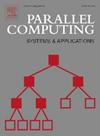GPU/CUDA-Accelerated gradient growth optimizer for efficient complex numerical global optimization
IF 2.1
4区 计算机科学
Q2 COMPUTER SCIENCE, THEORY & METHODS
引用次数: 0
Abstract
Efficiently solving high-dimensional and complex numerical optimization problems remains a critical challenge in high-performance computing. This paper presents the GPU/CUDA-Accelerated Gradient Growth Optimizer (GGO)—a novel parallel metaheuristic algorithm that combines gradient-guided local search with GPU-enabled large-scale parallelism. Building upon the Growth Optimizer (GO), GGO incorporates a dimension-wise gradient-guiding strategy based on central difference approximations, which improves solution precision without requiring differentiable objective functions. To address the computational bottlenecks of high-dimensional problems, a hybrid CUDA-based framework is developed, integrating both fine-grained and coarse-grained parallel strategies to fully exploit GPU resources and minimize memory access latency. Extensive experiments on the CEC2017 and CEC2022 benchmark suites demonstrate the superior performance of GGO in terms of both convergence accuracy and computational speed. Compared to 49 state-of-the-art optimization algorithms, GGO achieves top-ranked results in 67% of test cases and delivers up to 7.8× speedup over its CPU-based counterpart. Statistical analyses using the Wilcoxon signed-rank test further confirm its robustness across 28 out of 29 functions in high-dimensional scenarios. Additionally, in-depth analysis reveals that GGO maintains high scalability and performance even as the problem dimension and population size increase, providing a generalizable solution for high-dimensional global optimization that is well-suited for parallel computing applications in scientific and engineering domains.
GPU/ cuda加速梯度增长优化器,用于高效复杂的数值全局优化
高效求解高维复杂数值优化问题一直是高性能计算领域面临的重要挑战。本文提出了GPU/ cuda加速梯度增长优化器(GGO)——一种新的并行元启发式算法,它将梯度引导的局部搜索与GPU支持的大规模并行性相结合。在Growth Optimizer (GO)的基础上,GGO结合了一种基于中心差分近似的维度梯度引导策略,在不需要可微目标函数的情况下提高了求解精度。为了解决高维问题的计算瓶颈,开发了一种基于cuda的混合框架,集成了细粒度和粗粒度并行策略,以充分利用GPU资源并最小化内存访问延迟。在CEC2017和CEC2022基准套件上的大量实验表明,GGO在收敛精度和计算速度方面都具有优越的性能。与49种最先进的优化算法相比,GGO在67%的测试用例中获得了排名第一的结果,并且比基于cpu的算法提供了高达7.8倍的加速。使用Wilcoxon符号秩检验的统计分析进一步证实了其在高维场景中29个函数中的28个函数的稳健性。此外,深入分析表明,即使在问题维度和人口规模增加的情况下,GGO也能保持较高的可扩展性和性能,为高维全局优化提供了一种通用的解决方案,非常适合科学和工程领域的并行计算应用。
本文章由计算机程序翻译,如有差异,请以英文原文为准。
求助全文
约1分钟内获得全文
求助全文
来源期刊

Parallel Computing
工程技术-计算机:理论方法
CiteScore
3.50
自引率
7.10%
发文量
49
审稿时长
4.5 months
期刊介绍:
Parallel Computing is an international journal presenting the practical use of parallel computer systems, including high performance architecture, system software, programming systems and tools, and applications. Within this context the journal covers all aspects of high-end parallel computing from single homogeneous or heterogenous computing nodes to large-scale multi-node systems.
Parallel Computing features original research work and review articles as well as novel or illustrative accounts of application experience with (and techniques for) the use of parallel computers. We also welcome studies reproducing prior publications that either confirm or disprove prior published results.
Particular technical areas of interest include, but are not limited to:
-System software for parallel computer systems including programming languages (new languages as well as compilation techniques), operating systems (including middleware), and resource management (scheduling and load-balancing).
-Enabling software including debuggers, performance tools, and system and numeric libraries.
-General hardware (architecture) concepts, new technologies enabling the realization of such new concepts, and details of commercially available systems
-Software engineering and productivity as it relates to parallel computing
-Applications (including scientific computing, deep learning, machine learning) or tool case studies demonstrating novel ways to achieve parallelism
-Performance measurement results on state-of-the-art systems
-Approaches to effectively utilize large-scale parallel computing including new algorithms or algorithm analysis with demonstrated relevance to real applications using existing or next generation parallel computer architectures.
-Parallel I/O systems both hardware and software
-Networking technology for support of high-speed computing demonstrating the impact of high-speed computation on parallel applications
 求助内容:
求助内容: 应助结果提醒方式:
应助结果提醒方式:


